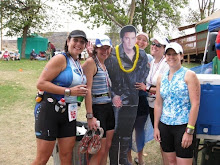Rob Wiley never worried much about how he began a new training cycle. He figured it was enough just to stay fit, running the same few miles just about every day at about the same easy pace. Then the 32-year-old project manager of Gurnee, Illinois, started working with a coach, Jenny Spangler. She had Wiley run hills and tempo runs in his base weeks, that six- to nine-week period of time before a formal training plan begins. "I thought, Why am I running hard stuff right out of the gate?" he says. The reason became apparent two months later, when he began stepping up his workouts. "I was strong," says Wiley—stronger than he had ever been entering a training season.
The experience was a revelation for Wiley. Proper base building isn't simply a matter of logging a decent number of miles, he realized. Instead, it serves as a bridge between the off-season's maintenance runs and a race-specific training program. "The purpose of base training is to prepare you for your next phase of harder, faster running," says Spangler, the 1996 U.S. Women's Olympic Marathon Trials champion. If you transition too quickly into the rigors of a training program, your ability to perform and, therefore, benefit from the work decreases while your risk of injury increases.
Because base training comes before you actually begin a training plan, it's often overlooked, says Spangler. In fact, quality work during this early phase is no less important than during your peak weeks. Faster-paced miles and the inclusion of a weekly long run increase endurance and strengthen your muscles, bones, and connective tissues. The improved fitness not only readies your body for the more intense running to come, it also allows you to safely handle tougher workouts, which increases the overall effectiveness of your entire training cycle.
Start Off Strong (Enough)
The key to successful base training is adding enough intensity to boost your fitness, but not so much that you get burned out or feel like you're training at your maximum too early. "There's no need to ever go above 95 percent of your maximum heart rate in base training," says Gordon Bakoulis, coach of Moving Comfort New York and a former 2:33 marathoner. "Fast 400 meters have no place in the base weeks."
Doing one or two quality workouts a week, such as hills, tempo runs, or fartlek sessions, will rev the cardiovascular system and stimulate the fast-twitch muscle fibers. A slightly longer run—of 45 to 90 minutes, depending on your fitness and goals—is also key. (For a two-week base-training program, see the end of this article) Sometimes, Bakoulis's athletes replace a tempo run with a race, which they don't run all out because they're not yet in peak shape. "It helps you retain the mental aspects of racing," says Bakoulis.
During base training, Spangler and Bakoulis both recommend gauging intensity by feel rather than by pace, since the number on your watch may push you to go faster than you're ready for. Gauging your effort allows you to run at the level right for that day. Plus, since much of base training takes place in the dark and cold of winter or early spring, achieving a certain pace becomes all that more difficult.
After Wiley added a few hill charges and 30-minute tempo runs to his formerly "easy" period, he ended up trimming two minutes off his half-marathon personal record. He decided to add quality runs into all his base training, and he ultimately set PRs in every distance from the 5K to the marathon. A little faster in the beginning meant a lot faster in the end.
Laying the Groundwork
Use the base-training plan below to develop endurance and strength prior to starting your next race-specific program. Follow this two-week block with one week of moderate runs. Repeat the three-week sequence two or three times for a total of six to nine weeks of base training. On tempo, hills, or fartlek days, warm up and cool down with a 10-minute easy run.
Day 1
Long run 45 to 90 minutes at what coach Jenny Spangler calls "a slight level of discomfort," or a moderate effort
Day 2
Rest, cross-train, or do a short, easy run
Day 3
Run 20 to 60 minutes at a moderate effort
Day 4
Long fartlek 3 or 4 3-minute surges at a 10-K to 10-mile effort, with 3 minutes easy running between fast segments
Day 5
Rest, cross-train, or short, easy run
Day 6
Hills 45 to 60 seconds at a hard effort; start with 4 repeats, build to 8 to 10; walk or jog downhill between repeats
Day 7
Rest
Day 8
Long run 45 to 90 minutes at an easy, conversational pace
Day 9
Rest, cross-train, or do a short, easy run
Day 10
Run 20 to 60 minutes at a moderate effort
Day 11
Short fartlek 10 to 15 minutes of 30-second to 2-minute bursts at a hard effort; recovery is equal to the duration of each fast segment
Day 12
Rest
Day 13
Rest or Run 20 to 60 minutes at a moderate effort
Day 14
Long tempo (or race): 20 to 40 minutes at half-marathon to marathon effort; 5-K or 10-K at a brisk but controlled pace.
Subscribe to:
Post Comments (Atom)





















No comments:
Post a Comment